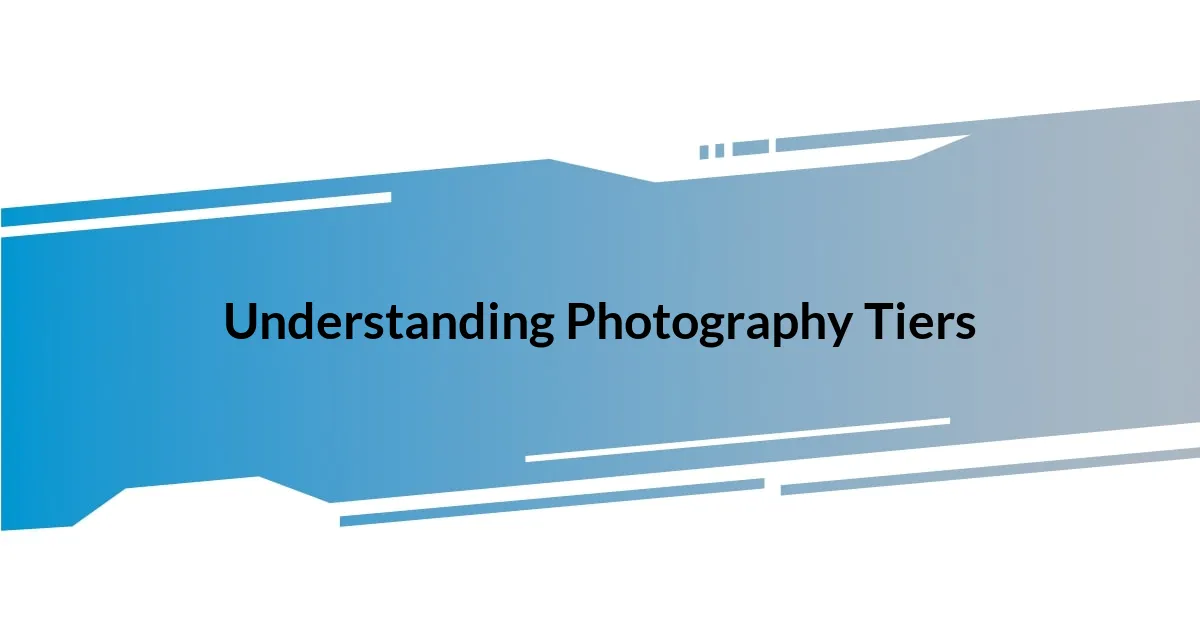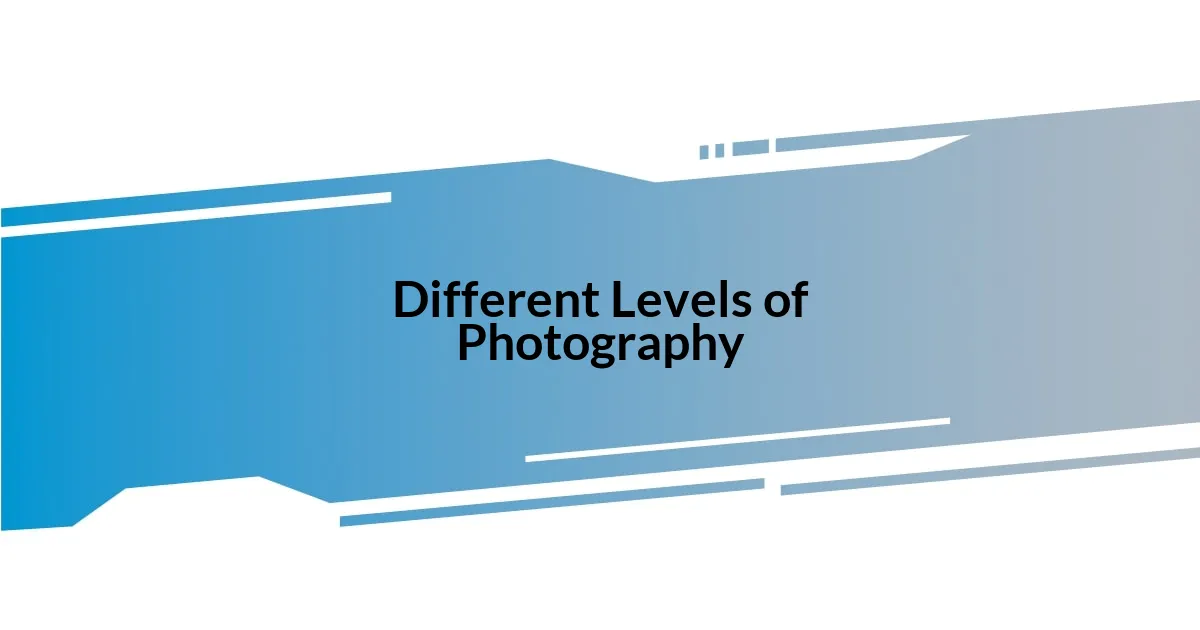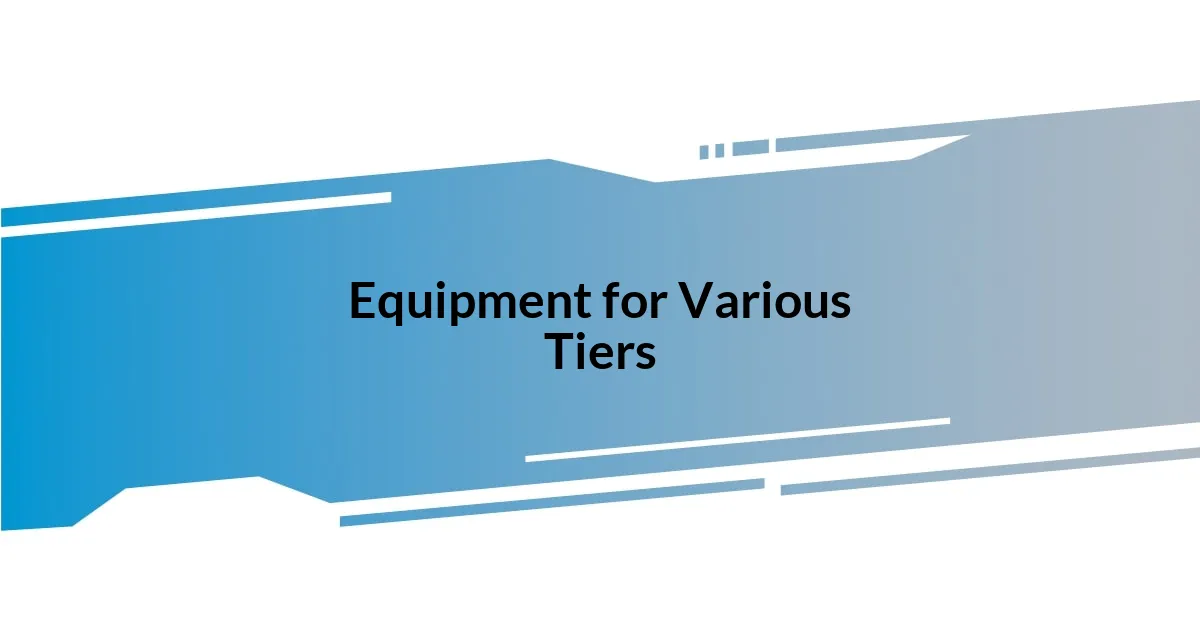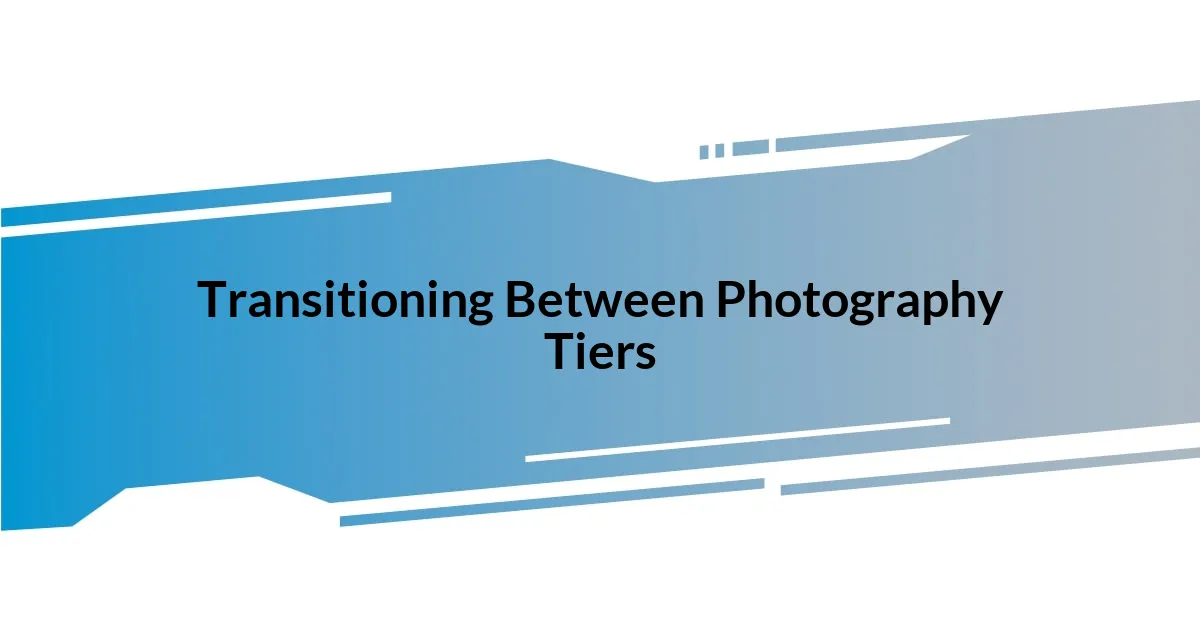Key takeaways:
- Progressing through photography tiers involves mastering technical skills, understanding composition, and developing a personal storytelling style.
- Each tier presents unique challenges and growth opportunities, often requiring both equipment upgrades and a shift in creative mindset.
- Effective pricing strategies evolve with experience, reflecting the photographer’s skill level, niche specialization, and the perceived value of their work.
- Collaboration and knowledge sharing within photography communities expedite skill development and foster a supportive environment.

Understanding Photography Tiers
Understanding photography tiers involves recognizing the varying levels of skill, equipment, and experience that differentiate photographers. I remember my early days, struggling with a basic camera while trying to capture the essence of a sunset. It was a humbling experience that made me realize how much I had to learn to move beyond the entry-level tier.
As someone who has watched my photography evolve over the years, I can tell you that each tier reflects not only technical prowess but also a deeper understanding of light, composition, and storytelling. At certain moments, I found myself questioning: what truly sets apart a novice from a pro? The answer often boiled down to the ability to convey emotions through images, which I found became clearer as I progressed into advanced tiers.
In my journey, I’ve encountered photographers at varying tiers, each with unique perspectives and techniques. For instance, speaking with a seasoned wedding photographer opened my eyes to the meticulous planning that goes into every shot, something I never considered as a beginner. It made me wonder, how can we, as aspiring photographers, bridge the gaps between these tiers to elevate our craft?

Different Levels of Photography
Understanding the different levels of photography can be quite the enlightening journey. I remember attending a local photography club, where I met enthusiasts ranging from beginners wielding smartphones to professionals with high-end DSLRs. Each tier brought its own strengths and challenges; for example, beginners often focus on learning basic concepts, while advanced photographers delve into complex techniques and post-processing styles.
Another intriguing aspect I’ve noticed is how each tier evolves with experience and curiosity. I recall a friend’s rapid rise from entry-level to intermediate; his obsession with understanding exposure settings unlocked new creative possibilities for him. It’s fascinating to witness how passion transforms the way photographers see the world, and this desire for growth often distinguishes casual shooters from dedicated artists.
As I immersed myself in various photography communities, I truly appreciated how these levels can foster a sense of camaraderie. It’s not just about the gear or the accolades; I’ve seen countless instances where experienced photographers generously share tips with newbies, creating a supportive environment. This sharing of knowledge spurred my own growth, proving that collaboration often speeds up the journey through photography tiers.
| Photography Tier | Characteristics |
|---|---|
| Beginner | Limited knowledge of settings; uses basic equipment; struggles with composition. |
| Intermediate | Understands camera settings; experiments with composition; often uses a mix of lenses. |
| Advanced | Mastery of techniques; proficient in post-processing; often specializes in a photography niche. |

Skills for Each Photography Tier
Developing the right skills for each photography tier takes time and practice. I still remember when I first realized the impact of composition; it was at a local park where I experimented with the rule of thirds. Capturing that one photo of a flower with just the right background burst opened my eyes to how deliberate framing changes everything.
In the journey through photography tiers, here are some critical skills to develop:
-
Beginner:
- Basic understanding of camera functions (aperture, shutter speed).
- Practicing composition techniques like framing and leading lines.
- Familiarity with shooting in different lighting conditions.
-
Intermediate:
- Strong grasp of exposure triangle and how it affects images.
- Experimentation with various lenses and their effects on photos.
- Learning simple post-processing techniques to enhance images.
-
Advanced:
- Mastering advanced techniques like long exposure and HDR.
- Proficiency in professional editing software such as Adobe Lightroom or Photoshop.
- Developing a unique style that reflects personal vision and storytelling.
Each of these skills builds upon the last, and I can’t emphasize enough how each step forward feels like unlocking a new door. As I honed my abilities, I found a sense of achievement that fueled my passion even more, proving how critical skill development is in this art form.

Equipment for Various Tiers
When it comes to equipment for various photography tiers, the choices can feel overwhelming. As a beginner, I remember investing in a simple point-and-shoot camera, which, although basic, allowed me to learn the fundamental aspects of framing and focus. It’s a great feeling when you realize that even the most straightforward equipment can lead to amazing pictures if used thoughtfully.
As I transitioned into the intermediate tier, I felt an exhilarating sense of freedom with my first DSLR. The ability to manually adjust settings like aperture and shutter speed opened up a new world of creative possibilities for me. It made me curious: how much could a new lens expand my skill set? I saved up for a versatile zoom lens, and it transformed my approach to photography, allowing me to explore various genres, from portraits to landscapes.
Now, in the advanced tier, my gear reflects my specialization, which is landscape photography. I’ve invested in a full-frame camera and professional-level lenses that do justice to the stunning scenery I love to capture. It’s mind-blowing to think about how far I’ve come; equipped with filters for long exposure and a sturdy tripod, my equipment reflects a culmination of both my experience and my passion. Can you believe that what started with a compact camera turned into a full kit tailored for capturing the world’s beauty?

Pricing Strategies Across Tiers
Effective pricing strategies across tiers can significantly impact the success of a photography business. When I first started, I struggled with what to charge; I found myself offering far too much for too little, thinking it would attract clients. However, as I learned, understanding the value of my time and skills was crucial. Setting prices too low can undermine the perception of quality in my work.
As I advanced in my photography journey, I realized that pricing shouldn’t just be about covering expenses—it’s about appeal. For intermediate tier photographers, tiered pricing can be effective. For example, offering packages for families or events at varying levels gives clients the flexibility to choose what suits them best. Watching clients deliberating over these choices helped me understand how important it is for them to feel in control. Have you ever felt the relief of having options? It influences their decision-making process profoundly.
Now, in my advanced tier, I’ve tailored my pricing to reflect my specialization. By focusing on a niche—like fine art photography—I can charge premium prices that justify the quality of my work, incorporating the extensive time and creativity I invest. This brings up an interesting point: how do you determine your worth? I found that aligning my prices with the unique value I provide allowed me not only to attract the right clients but also to build deeper relationships based on mutual appreciation. Seeing clients genuinely thrilled with my work makes the intricate pricing dance worth it.

Transitioning Between Photography Tiers
Transitioning between photography tiers is often a transformative experience. I remember the moment vividly when I realized I had outgrown my basic camera. It was during a stunning sunrise shoot that the limitations of my gear became apparent; I wanted to capture the vibrant colors and fine details, but my point-and-shoot struggled. This pushed me to leap into a DSLR, and it’s hard to describe the thrill of that first manual shot—everything suddenly felt within my control.
As I progressed, each tier felt like climbing a new height. I distinctly recall the challenge of adapting to new techniques and styles that came with upgraded equipment. The jump from intermediate to advanced wasn’t just about the gear; it was a mindset shift, too. I found myself craving more than just great pictures; I wanted to tell stories through my photographs. Have you experienced a moment where your perspective on your art changed? Feelings like that can spark tremendous growth, ultimately leading to a vehicle of expression that feels true to you.
Now, as I reflect on my journey, those transitions seem almost like rites of passage. Each tier required me to assess not just my equipment but also my technical knowledge and artistic vision. I still remember the moments of doubt when I questioned my skills, yet, they always steered me toward growth. Embracing every new challenge is what truly fosters progress. Isn’t it fascinating how each step opens up new creative avenues? This personal evolution is what keeps fueling my passion for photography.